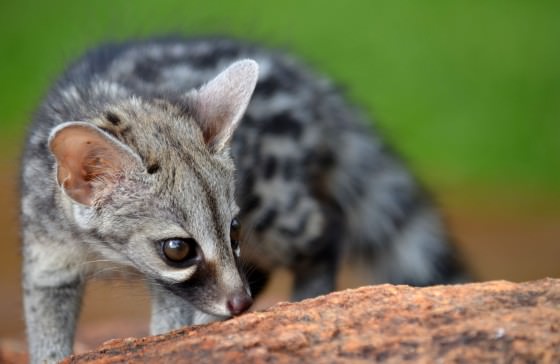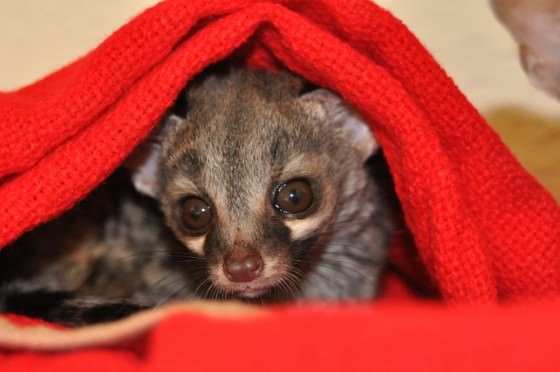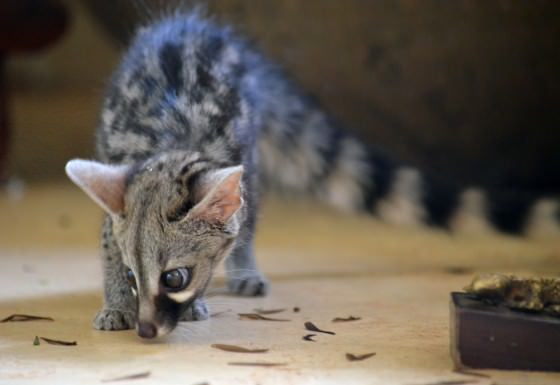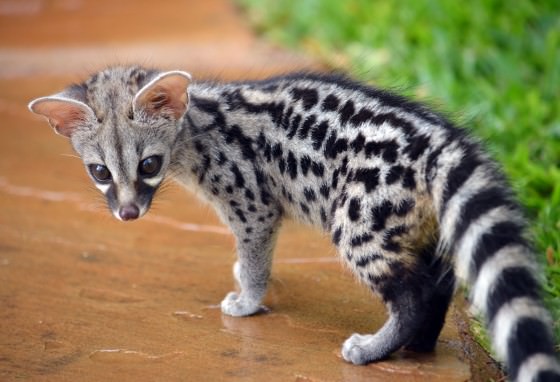A genet cat is not really a cat.
It is related to the cat family but not as closely as it is to civets and mongooses; however, it does resemble a cat and shares many of their characteristics and behaviours. They are distributed across much of Africa and parts of Southern Europe and the Middle East.
In Kenya they can be found almost everywhere, including residential areas surrounding the capital city of Nairobi. They are nocturnal and very shy so rarely spotted unless they have been habituated. It is common for lodges and camps in the wilder parts of Kenya to leave food out for genets so that guests can be treated to an evening sighting. They are very crafty though, and if you’re not paying attention you might easily miss them altogether. Given the option they will quickly gather up food in their mouth and dash back in to the darkness before you’ve realised they were there.
Even without offering them regular morsels they will often sneak into camps and lodges attracted by scraps that might have been missed at the table. Unsecured storerooms and boxes of food also present an irresistible invitation to a hungry genet. During certain parts of the year they will be lured by the thousands of beetles, moths, flying ants and other insects that are attracted to artificial lights and will gorge themselves -- usually once everyone has retired for the night.

Their diet is highly varied and may include insects, birds, bats, rodents, eggs, small reptiles, and even some plants. They are very territorial and rarely socialise outside of reproduction. The females are therefore responsible for rearing the kittens, as males only make themselves available for mating.

The David Sheldrick Wildlife Trust recently became entrusted with the care of two week-old genet cat kittens that were discovered on their own by a team of Kenya Wildlife Service rangers patrolling in the Taita/Taveta area of Tsavo near Voi. It is unknown what happened to their mother, but the kittens would have quickly died without attention. They were dropped off at the DSWT Voi elephant stockades from where they were sent up to DSWT’s Tsavo headquarters in Mtito Andei.
Looking after baby genet cats is not much different than caring for a human baby in that they require frequent feeding (every three hours or so) 24 hours a day. Unlike human babies, they are unable to pass bowel movements or urinate on their own and need to be stimulated with a small stick or a wet rag. In the wild, their mother would stimulate them with the lapping of a tongue. It does simplify “toilet” training, however, as you can control when and where they “use the bathroom.” They quickly learn what to do and where to do it and in a few weeks will be using a litter box without much persuasion.

Unlike human babies, they are very difficult to feed since they are too small to suckle from a bottle. Instead, a rubber tube attached to the end of a syringe can be used. It does take quite some time and a lot of patience for them to learn to suckle naturally but they catch on soon enough. After a few weeks they will show some interest in minced meat and can be slowly weaned off the syringe. In the wild they are generally born shortly before the rains when large numbers of insects congregate and breed. The insects are the perfect subjects for training to hunt, and with very little encouragement, little kittens will begin chasing down and eating their own prey.


This is just the beginning, though, and it will be many more months before they are completely independent. The world is full of challenges for a little genet cat and one day very soon every young cat will have to stamp out its own territory.
